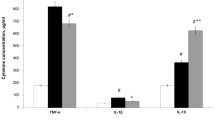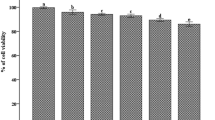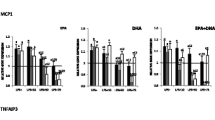Abstract
The present study is supported by our previous findings suggesting that calcium fructoborate (CF) has anti-inflammatory and antioxidant properties. Thus, we investigated the effects of CF on a model for studying inflammatory disorders in vitro represented by lipopolysaccharide (LPS)-stimulated murine macrophage RAW 264.7 cells. This investigation was performed by analyzing the levels of some mediators released during the inflammatory process: cytokines such as tumor necrosis factor-α (TNF-α), interleukins IL-1β and IL-6 as well as cyclooxygenase-2 (COX-2), the main enzyme responsible for endotoxin/LPS-induced prostaglandin synthesis by macrophages. We also measured production of nitric oxide (NO) that plays an important role in the cytotoxicity activity of macrophages towards microbial pathogens. After CF treatment of LPS-stimulated macrophages we found an up-regulation of TNF-α protein level in culture medium, no significant changes in the level of COX-2 protein expression and a decrease in NO production as well as in IL-1β and IL-6 release. Collectively, this series of experiments indicate that CF affect macrophage production of inflammatory mediators. However, further research is required in order to establish whether CF treatment can be beneficial in suppression of pro-inflammatory cytokine production and against progression of endotoxin-related diseases.







Similar content being viewed by others

References
Nielsen FH (1997) Boron in human and animal nutrition. Plant Soil 193:199–208
Armstrong TA, Spears JW, Lloyd KE (2001) Inflammatory response, growth, and thyroid hormone concentrations are affected by long-term boron supplementation in gilts. J Anim Sci 79:1549–1556
Armstrong TA, Spears JW (2003) Effect of boron supplementation of pig diets on the production of tumor necrosis factor-alpha and interferon-gamma. J Anim Sci 81:2552–2561
Hunt CD, Idso JP (1999) Dietary boron as a physiological regulator of the normal inflammatory response: a review and current research progress. J Trace Elem Exp Med 12:221–233
Hu H, Penn SG, Lebrilla CB, Brown PH (1997) Isolation and characterization of soluble boron complexes in higher plants. The mechanism of phloem mobility of boron. Plant Physiol 113:649–655
Miljkovic D (1999) US patent 5.962.049 (issued October 5, 1999)
Miljkovic D (2000) US patent 6.080.425 (issued June 27, 2000)
Wagner CC, Ferraresi Curotto V, Pis Diez R, Baran EJ (2008) Experimental and theoretical studies of calcium fructoborate. Biol Trace Elem Res 122:64–72
Scorei R, Ciubar R, Iancu C, Mitran V, Cimpean A, Iordachescu D (2007) In vitro effects of calcium fructoborate on fMLP-stimulated human neutrophil granulocytes. Biol Trace Elem Res 118:27–37
Scorei R, Cimpoiasu VM, Iordachescu D (2005) In vitro evaluation of the antioxidant activity of calcium fructoborate. Biol Trace Elem Res 107:127–134
Scorei R, Ciubar R, Ciofrangeanu CM, Mitran V, Cimpean A, Iordachescu D (2008) Comparative effects of boric acid and calcium fructoborate on breast cancer cells. Biol Trace Elem Res 122:197–205
Bradford MM (1976) A rapid and sensitive method for the quantitation of microgram quantities of protein utilizing the principle of protein-dye binding. Anal Biochem 72:248–254
Gabay C, Kushner I (1999) Acute-phase proteins and other systemic responses to inflammation. N Engl J Med 340:448–454
Bode JG, Schweigart J, Kehrmann J, Ehlting C, Schaper F, Heinrich PC, Haussinger D (2003) TNF-α induces tyrosine phosphorylation and recruitment of the Src homology protein-tyrosine phosphatase 2 to the gp130 signal-transducing subunit of the IL-6 receptor complex. J Immunol 171:257–266
Ma Q, Kinneer K (2002) Chemoprotection by phenolic antioxidant. Inhibition of TNF-α induction in macrophages. J Biol Chem 277:2477–2492
Zychlinsky A, Fitting C, Cavaillon JM, Sansonetti PJ (1994) Interleukin 1 is released by murine macrophages during apoptosis induced by Shigella flexneri. J Clin Invest 94:1328–1332
Cao J, Jiang L, Zhang X, Yao X, Geng C, Xue X, Zhong L (2008) Boric acid inhibits LPS-induced TNF-alpha formation through a thiol-dependent mechanism in THP-1 cells. J Trace Elem Med Biol 22:189–195
Benderdour M, Hess K, Dzondo-Gadet M, Dousset B, Nabet P, Belleville F (1997) Effect of boric acid solution on cartilage metabolism. Biochem Biophys Res Commun 234:263–268
Benderdour M, Hess K, Dzondo-Gadet M, Nabet P, Belleville F, Dousset B (1998) Boron modulates extracellular matrix and TNFα sythesis in human fibroblasts. Biochem Biophys Res Commun 246:746–751
Yao J, Mackman N, Edgington TS, Fan ST (1997) Lipopolysaccharide induction of the tumor necrosis factor-alpha promoter in human monocytic cells. Regulation by egr-1, c-jun and NF-kappaB transcription factors. J Biol Chem 272:17795–17801
Means TK, Pavlovich RP, Roca D, Vermeulen MW, Fenton MJ (2000) Activation of TNF-alpha transcription utilizes distinct MAP kinase pathways in different macrophage populations. J Leukocyte Biol 67:885–893
Tsai EY, Falvo JV, Tsytsykova AV, Barczak AK, Reimold AM, Glimcher LH, Fenton MJ, Gordon DC, Dunn IF, Goldfeld AE (2000) A lipopolysaccharide-specific enhancer complex involving Ets, Elk-1, Sp1 and CREB binding protein and p300 is recruited to the tumor necrosis factor alpha promoter in vivo. Mol Cell Biol 20:6084–6094
Pradervand S, Maurya MR (2006) Subramaniam S Identification of signaling components required for the prediction of cytokine release in RAW 264.7 macrophages. Genome Biol 7:R11
Calder PC (2003) N − 3 polyunsaturated fatty acids and inflammation: from molecular biology to the clinic. Lipids 38:343–352
Rees D, Miles EA, Banerjee T, Wells SJ, Roynette CE, Wahle KW, Calder PC (2006) Dose-related effects of eicosapentaenoic acid on innate immune function in healthy humans: a comparison of young and older men. Am J Clin Nutr 83:331–342
Hardardóttir I, Kinsella JE (1992) Increasing the dietary (n − 3) to (n − 6) polyunsaturated fatty acid ratio increases tumor necrosis factor production by murine resident peritoneal macrophages without an effect on elicited peritoneal macrophages. J Nutr 122:1942–1951
Ferrucci L, Cherubini A, Bandinelli S, Bartali B, Corsi A, Lauretani F, Martin A, Andres-Lacueva C, Senin U, Guralnik JM (2006) Relationship of plasma polyunsaturated fatty acids to circulating inflammatory markers. J Clin Endocrinol Metab 91:439–446
Nielsen FH (2002) Does boron have an essential function similar to an omega-3 fatty acid function? In: Anke, M, Muller R, Schafer U, Stoeppler M (eds) Macro and trace elements, Friedrich Schiller University, Jena, Germany, October:18-19. Schubert-Verlag, Leipzig, Germany, pp 1238-1250
Nathan C, Xie QW (1994) Nitric oxide synthases. Roles, tolls, and controls. Cell 78:915–918
Albina JE, Cui S, Mateo RB, Reichner JS (1993) Nitric oxide-mediated apoptosis in murine peritoneal macrophages. J Immunol 150:5080–5085
Jeon YJ, Young KK, Lee M, Park SM, Han SB, Kim HM (2000) Radicicol suppresses expression of inducible nitric-oxide synthase by blocking p38 kinase and Nuclear Factor-kB/Rel in lipopolysaccharide-stimulated macrophages. J Pharmacol Exp Ther 294:548–554
Beyaert R, Cuenda A, Vanden Berghe W, Plaisance S, Lee JC, Haegeman G, Cohen P, Fiers W (1996) The p38/RK mitogen-activated protein kinase pathway regulates interleukin-6 synthesis response to tumor necrosis factor. EMBO J 15:1914–1923
Foey AD, Parry SL, Williams LM, Feldmann M, Foxwell BM, Brennan FM (1998) Regulation of monocyte IL-10 synthesis by endogenous IL-1 and TNF-α: Role of the p38 and p42/44 mitogen activated protein kinases. J Immunol 160:920–928
Eigler A, Moeller J, Endres S (1995) Exogenous and endogenous nitric oxide attenuates tumor necrosis factor synthesis in the murine macrophage cell line RAW 264.7. J Immunol 154:4048–4054
Williams JA, Shacter E (1997) Regulation of macrophage cytokine production by prostaglandin E2. Distinct roles of cyclooxygenase -1 and -2. J Biol Chem 272:25693–25699
van den Berg R, Peters JA, van Bekkum H (1994) The structure and (local) stability constants of borate esters of mono- and di-saccharides as studied by 11B and 13C NMR spectroscopy. Carbohydr Res 253:1–12
Luan Q, Desta T, Chehab L, Sanders VJ, Plattner J, Graves DT (2008) Inhibition of experimental periodontitis by a topical boron-based antimicrobial. J Dent Res 87:148
Mattingly LH, Ruth A, Gault, Murphy WJ (2007) Use of systemic proteasome inhibition as an immune-modulating agent in disease. Endocrine, Metabolic & Immune Disorders - Drug Targets 7:29–34
Author information
Authors and Affiliations
Corresponding author
Rights and permissions
About this article
Cite this article
Scorei, R.I., Ciofrangeanu, C., Ion, R. et al. In Vitro Effects of Calcium Fructoborate upon Production of Inflammatory Mediators by LPS-stimulated RAW 264.7 Macrophages. Biol Trace Elem Res 135, 334–344 (2010). https://doi.org/10.1007/s12011-009-8488-5
Received:
Accepted:
Published:
Issue Date:
DOI: https://doi.org/10.1007/s12011-009-8488-5



